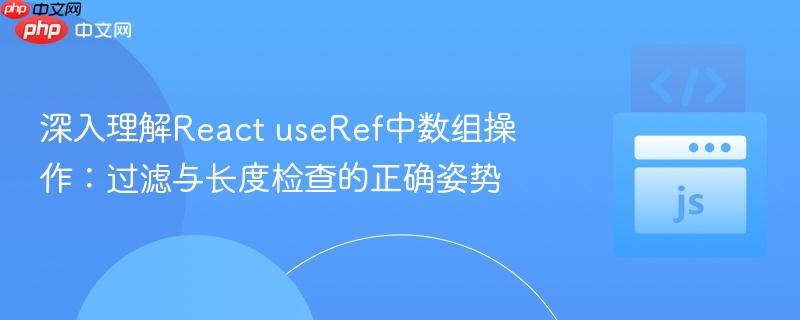
本文旨在解决在react应用中使用`useref`管理数组时常见的操作误区。核心在于`array.prototype.filter()`等数组方法会返回新数组而非原地修改,因此必须将过滤结果重新赋值给`ref.current`。同时,强调访问`useref`的值时,务必通过`ref.current`属性,尤其是在检查数组长度时,以确保逻辑的正确性。
在React开发中,useRef Hook 提供了一种在组件的整个生命周期内持久化可变值的方法,而不会触发组件重新渲染。它通常用于直接访问DOM节点、存储任何可变值(如定时器ID、非受控组件的值),或者在不需要触发UI更新时管理数据。当我们需要处理一个不直接影响渲染,但需要在组件实例中保持其最新状态的数据集合时,例如一个隐藏物品游戏中的物品列表,useRef是一个合适的选择。
然而,在使用useRef存储数组并对其进行操作时,开发者常会遇到一些陷阱,特别是与JavaScript数组方法的特性结合时。
考虑以下场景:在一个隐藏物品游戏中,当玩家找到一个物品后,需要将其从物品列表中移除。如果该物品列表存储在useRef中,开发者可能会尝试使用Array.prototype.filter()方法来移除找到的物品,代码可能如下所示:
let items = useRef([]); // 存储物品列表
// ... 其他代码 ...
function handleAction(click, toy){
// 查找物品的逻辑...
const item = items.current.find(item => item.name === toy );
if (item) {
// 尝试过滤掉已找到的物品
items.current.filter((item) => item.name !== toy); // 错误示范
console.log(items.current); // 此时items.current并未改变
}
}问题分析:
Array.prototype.filter()方法不会修改原始数组。它会创建一个新数组,其中包含通过指定回调函数测试的所有元素。因此,仅仅调用items.current.filter(...)并不会改变items.current所引用的数组。原始的items.current数组仍然保持不变,导致物品并没有被成功移除。
要正确地从useRef管理的数组中移除元素,你需要将filter()方法返回的新数组重新赋值给ref.current。这样,ref.current就会指向更新后的数组。
import {useNavigate} from 'react-router-dom';
import { useState, useEffect, useRef} from "react";
import supabase from "../config/supabaseClient";
import Image from "./image"
import Timer from "./timer";
const Game = ()=>{
let items = useRef([]); // 存储物品列表
const [fetchError, setFetchError] = useState(null);
const [found, setFound] = useState("");
const [time, setTime] = useState(0);
const navigate = useNavigate();
useEffect(()=>{
const fetchOptions = async()=>{
const{data,error} = await supabase
.from('items')
.select();
if(error){
setFetchError('Could not fetch items');
items.current = [];
}
if(data){
items.current = data;
setFetchError(null);
}
}
fetchOptions();
},[])
function handleAction(click, toy){
const item = items.current.find(item => item.name === toy )
if(!item){
setFound(`Not quite, try again!`);
return;
}
if(click.x>item.left&&click.x<item.right){
if(click.y<item.bottom&&click.y>item.top){
setFound(`Well done! You've found Sarah's ${toy}`);
// 正确的过滤方式:将新数组重新赋值给 items.current
items.current = items.current.filter((i)=>i.name!==toy); // 注意这里使用 i 避免变量名冲突
console.log(items.current); // 此时items.current已更新
// ... 后续的逻辑 ...
}
}else{
setFound(`Not quite, try again!`);
return;
}
}
return(
<>
{fetchError&&(<p>{fetchError}</p>)}
<Timer time={time} setTime={setTime}/>
<Image handleAction={handleAction}/>
<p>{found}</p>
<div class="aritcle_card">
<a class="aritcle_card_img" href="/ai/2447">
<img src="https://img.php.cn/upload/ai_manual/001/246/273/176620077732160.png" alt="知识画家">
</a>
<div class="aritcle_card_info">
<a href="/ai/2447">知识画家</a>
<p>AI交互知识生成引擎,一句话生成知识视频、动画和应用</p>
<div class="">
<img src="/static/images/card_xiazai.png" alt="知识画家">
<span>8</span>
</div>
</div>
<a href="/ai/2447" class="aritcle_card_btn">
<span>查看详情</span>
<img src="/static/images/cardxiayige-3.png" alt="知识画家">
</a>
</div>
</>
);
}
export default Game;通过items.current = items.current.filter(...),我们确保了items.current始终指向最新、已过滤的数组。
另一个常见的错误是,当需要检查useRef中数组的长度时,错误地访问了ref对象本身的length属性,而不是其current属性所指向的数组的length。
// ... 在 handleAction 函数内部 ...
if(items.length === 0){ // 错误示范:items 是一个 ref 对象,没有 length 属性
console.log('Winner');
navigate("/leaderboard", {state:time});
}问题分析:
items是一个useRef Hook 返回的对象,其结构为{ current: value }。它本身没有length属性。只有items.current(即实际的数组)才具有length属性。因此,items.length会返回undefined或导致其他非预期行为。
要正确检查useRef中数组的长度,必须通过ref.current.length来访问。
// ... 在 handleAction 函数内部 ...
if(items.current.length === 0){ // 正确示范
console.log('Winner');
navigate("/leaderboard", {state:time});
}遵循这些原则,可以避免在React中使用useRef管理数组时常见的逻辑错误,确保应用程序的健壮性和可维护性。
以上就是深入理解React useRef中数组操作:过滤与长度检查的正确姿势的详细内容,更多请关注php中文网其它相关文章!

每个人都需要一台速度更快、更稳定的 PC。随着时间的推移,垃圾文件、旧注册表数据和不必要的后台进程会占用资源并降低性能。幸运的是,许多工具可以让 Windows 保持平稳运行。

Copyright 2014-2025 https://www.php.cn/ All Rights Reserved | php.cn | 湘ICP备2023035733号